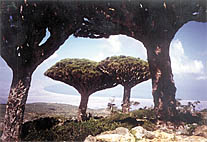
Yemen and Slovenia TVs to Produce Two Documentary Films on Yemen [Archives:2000/09/Last Page]
February 28 2000

Q: How did the idea of the films come about?

Q: Who will produce the films?
A: There are three co-producers: Yemen TV, Slovenia TV and Arsmedia as an executive producer.
Slovenian TV will provide a film director, camera operator, equipment like film 16 mm camera of a high quality and all post production, music, words, etc. The film will be produced in the highest technical and artistic standards. The film director is a very known film director in my country and a winner of one of the world famous prizes called Gold Butterfly Prize in the field of documentary film. Our ambition is to have these films compete with other films in international festivals. This should be a big promotion to the Yemeni TV as a co-producer. In this way Yemen TV will be participating, as I know, for the first time in such a festival.
For its side, Yemen TV’s contribution will be a companion who will be all the time with us and a video cameraman. Surly we have a contract for this co-production and we are obliged to give one professional copy to Yemen TV.
Q: What will Yemen benefit from these films?
A: The films are about Yemen. It will be transmitted on Slovenian satellite covering the whole of Europe. It will also be transmitted on the Yemen TV to cover the Arab world. We will also participate in some documentary films festivals and we hope there will be interest in them. This will be a good opportunity for Yemen because the film will be transmitted in different foreign countries. The film will show the beauty of the country and present the various kinds of architecture and some of important archeological places.
Introducing the country in this way will be a tourist propaganda even this is not our main aim.
Q: When did you start the project?
A: I was here in 1994 to make test shots then I came 1998 twice. All things were concluded in these visits. My team will arrive in Yemen on 19 and we will start soon from the next morning. Then we will stay for three days in Sanaa. I have already prepare what should be done next in Marib, Shabwa and Hadhramout. On 3 March we will go to Socotra island, stay there for one weak, and coming back then to Sanaa to finish shooting for this part. We are coming again in November to continue filming in other parts of the country and I hope that the films will be ready in the beginning of the next year.
Q: Why have you chosen Socotra in particular to be the story of a whole film?
A: Socotra is a very magnificent island. I suppose that many Yemenis know little about it. Personally, I was informed about Socotra from different sources, the most important one was a study done by a Russian scientist that I found at the American Institute for Yemeni Studies. Then I decided to go there and I visited Socotra in November last year. I found it more exciting than I had expected.
According to geological history the island was very isolated. Its animals, plants and even people used to dwell in a very specific way far away from Africa and far away from the Arab world. Among 850 plant species, 280 are in endemic, this means that they are to be found only on Socotra. There are also some endemic animals, particularly birds. 80% of the reptiles in the islands is endemic.
The island was populated three thousand years ago. People came from southern Arab peninsula mostly from Mahra area and because of a 3 thousand-year life in isolation they developed their own language called Socotra that is only spoken.
I enjoyed my stay there. People are very friendly. I have never found people as friendly as Socotri people. On the other hands Socotra is now opening an airport and building an economic off-shore area and the isolation of the island should be finished. The island is absolutely undeveloped and without any tourist infrastructure.
It was very important for me to find there the UNDP Socotra Bio-Diversity Project, headed by Dr. Edoardo Zandri researching island and preparing the program of protecting the environment. They are well organized and they also offered us assistance in filming.
Q: What are your future plans concerning Yemen?
A: My next project is organizing the Exhibition of Yemen Culture in Slovenian capital Ljubljana. We have already received the positive response from the Ministry of Culture and Tourism of Yemen and it should be opened at the end of 2001.
Q: Any last word?
A: The film is supported by the Ministry of Culture and Tourism of the Republic of Yemen represented by HE. Mr. Abdul Malik Mansour, Yemen Airways, Universal Travel and Tourism represented by Mr. Marco Livadiotti, YATA represented by Dr. Dietmar Quist and of course, Radio and Television Corporation of Yemen represented by Mr. Hussain Moqbel.
Finally, I would like to note that the budget of our filming project has not been covered. So we kindly invite individuals and companies from Yemen and abroad who are interested in promotion of Yemen who like to sponsor or support our filming activities or who are interested in filming materials or photographs on Yemen to contact us to the following addresses:
Fax: + 967 1 273 256 NTSC Co. Sanaa
Fax: + 386 61 1590486 Ljubljana, Slovenia
–mail: [email protected]
——
[archive-e:09-v:2000-y:2000-d:2000-02-28-p:./2000/iss09/lastpage.htm]


